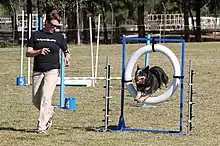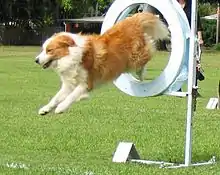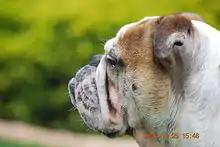Australian National Kennel Council
The Australian National Kennel Council (ANKC) is the coordinating kennel club of Australia.[1] The ANKC is a member of the Fédération Cynologique Internationale.
 | |
| Abbreviation | ANKC |
|---|---|
| Formation | 1958 |
| Type | Kennel club |
| Legal status | Active |
Region served | Australia |
| Website | ankc.org.au/ |
Role
The Australian National Kennel Council is the peak body for Australia's state-based kennel clubs, which are:[2]
- Australian Capital Territory Canine Association Inc (Dogs ACT)
- Canine Association of Western Australia Inc (Dogs West)
- Canine Control Council (Queensland) (Dogs Qld)
- North Australian Canine Association Inc (Dogs NT)
- Royal New South Wales Canine Council Ltd (Dogs NSW)
- South Australia Canine Association Inc (Dogs SA)
- Tasmanian Canine Association Inc (Dogs Tas)
- Victorian Canine Association Inc (Dogs Vic)
The Australian National Kennel Council maintains breed registries for purebred dogs it officially recognises and provides governance for Australian National Kennel Council approved dog conformation shows, dog trials and canine events. The Australian National Kennel Council also represents Australia's kennel clubs internationally as a member of the Fédération Cynologique Internationale.[1][3]
History
The first meeting to consider forming the Australian National Kennel Council occurred in April 1949 during that year's Sydney Royal Easter Show. It was not until April 1958 that a constitution was drafted and presented at the Royal Easter Show, with it being approved and the council forming in September that year at the Royal Melbourne Show.[4]
Role and structure of ANKC


The Australian National Kennel Club (ANKC) was organised in 1949 to provide advice and promote cooperation between the existing state canine authorities.[5] Over time, the ANKC role has expanded besides the role of coordinating and recommending. It has several defined roles ranging from promoting and improving purebred dog events in Australia, maintaining national pure breed dog registration and breed standard, collecting and publishing statistical information on purebred dog breeding in Australia, through to researching canine health with funding from the Canine Research Foundation.[5] In 2011, the ANKC registered with the Australian Securities and Investment Commission (ASIC) as a company limited under the name Australian National Kennel Council Limited.[5]
The ANKC is the peak body for another 8 Australia's state-based canine associations.[5] They shared the same objective to promote purebred dog breeding and purebred dogs event in Australia.[5]
Regulations of canine breeding in Australia
Current regulatory framework
The current regulatory framework in the breeding of companion animals in Australia can be divided into four components.[5] They focused on property, management, the animal itself and breeding respectively.[5] The first component comprises the civil laws and consumer laws applied by the Australian Competition and Consumer Commission (ACCC). It provides rights for dog owners to assert ownership of their dog and to protect the value of their dog.[5] The second component comprises laws and regulations by the state and local government and RSPCA that calls for good management of dogs from dog owners and prevent them from causing damage and becoming a nuisance.[5][6] The third component comprises regulations by national government and RSPCA that protect the welfare and rights of individual companion animals.[6][5] The sake of this component is to prevent animal cruelty and enhance animal welfare, such legislation has developed in each State and Territory over time.[6][5] Lastly, the fourth component comprises regulations that regulate breeding and trading dogs that regulated by the state government with state breeding codes under New South Wales, Victoria, ANKC and similar to industry breeding codes.[5] At a breeding industry, National and State codes and breeding standards will guide registered pure breed dogs breeding in different breeds.[5] These industry codes also regulate how member breeders conduct in dog events and regulating these registered pure breed dog breeders in the way of trading their dogs.[5]
The effectiveness of the ANKC regards to the current regulatory framework
A study published by the University of Tasmania revealed few issues when evaluating how ANKC performing on its role in addressing the issues in dog breeding.[5] Rather than the commercial aspects of breeding that is opposed by dog owners, it is found that the breeding practices comply on dog health is the most concern to dog owners.[5] Thus the ANKC should reconsider the clauses in their code that opposed to commercial breeding.[5] Instead, to comply with rules that ensure breeder breed responsibly. Moreover, multiple changes on regulatory rules are calling for the licensing of dog breeders, the implementation of an effective enforcement strategy, mandatory genetic testing and disclosures and the introduction of an approved breeders scheme.[5] On the other hand, changes in non-regulatory rules are calling for the provision of more effective educational programs and material for both breeders and owners.[5] Overall, a more responsive and collaborating regulatory environment should be achieved to promote higher animal welfare standards with both ANKC and the State or Territory canine associations and how to maintain and monitor appropriately after establishing regulation in compliance programs.[5] Overall, it is considered as ineffective of how ANKC cooperate with the State or Territory canine associations in addressing the issues in dog breeding.
Another study published in 2011 also concerned the commercial breeding of dogs in Australia has failed to self-regulate effectively.[6] This is mainly due to the lack of information available to consumers in how the animals are raised.[6] As poor living conditions and deplorable treatment of animals are concerned when raising pups. This paper highlighted the importance of basic requirement in animal breeding and raising such as conditions of housing, transportation, limits on breeding, record keeping on animals breeding and daily exercises requirement.[6] In additional, the author also aware of the absence of a national code of practices that can lead to a lack of guarantee of puppies welfare when selling, transporting or breeding.[6] Especially for Queensland, the Northern Territory, Western Australia and Tasmania, there is no uniform codes of practice in the mentioned practices.[6] Thus, this paper emphasized the importance of having regulations set up to ensure animal welfare when breeding purebred dogs.
Australian registered dog breeds and breeders


There are currently an estimated 4.8 million pet dogs living in the Australian household.[7] Over 200 pure breeds are registered with the ANKC.[8] 7 breed groups are classified by the ANKC, which are (1) Toy dog, (2) Terrier, (3) Gundog, (4) Hound, (5) Working dog, (6) Utility and (7)Non-Sporting.[8] Each purebred dog in Australia has a breed standard that setting their physical characteristics such as size, coat length and colour, height, body conformation, facial appearance and gait of the dog.[8] This breed standard is compared in every conformation dog show.[5] Additionally, certain behaviours such as the ability of herding and hunting, temperament and trainability are also taken into account when breeding dogs.[8]
Breeders in Australia can categories in three groups: (1) Commercial breeders, (2) Pedigree recreational hobby breeders and (3) Backyard and occasional breeders. The second group are breeders that breed pure breed dogs as a member of the canine association for instance the ANKC. In 2015, there are 32,481 members registered as an ANKC member. 20% of them were active breeders and produced 69,274 puppies. A study published in 2016 revealed that a majority of 274 ANKC breeders bred only a single dog breed and kept three bitches and two dogs for breeding, and bred a maximum of two litters a year.[8] Another study published in 2016 studied the trend of purebred dog registered in ANKC from 1986 to 2013 suggested that shorter and smaller breeds are becoming relatively popular compared to taller and larger breeds.[9]
Australian dog owners
.jpg.webp)
A study published in 2019 revealed that Australian dog owners can be divided into two main groups which the first group is dog seekers that prioritise a rescue dog, their temperament, compatibility with their household and the second group is dog seekers that prioritise a particular morphotype of dog, compatibility with their household, their temperament and having optimal breeding practice such as registration of breeder.[10] It is also found that the later dog seekers are more satisfied with their acquisition choice than the former which suggested that registered breeders are still needful even though it is highly criticized by public due to the neglect of animal welfare when breeding.[10]
Another study published in 2018 revealed ANKC breeders were motivated to breed their first litter of puppies with fit and healthy companion animals and for the betterment of the breed in Australia rather than to breed to meet the ANKC standard or to fit their original purpose such as working or service dogs.[5] Most of the breeders describe their business as a hobby, only a very little of the breeders aimed to make a financial gain as a source of income when breeding.[5]
Welfare issues raised in kennel club
Media and public attention
| Pedigree Dogs Exposed | |
|---|---|
| Genre | Documentary |
| Narrated by | Jemima Harrison |
| Country of origin | United Kingdom |
| Production | |
| Producer | Jemima Harrison |
| Running time | 60 minutes |
| Production company | Passionate Productions |
| Release | |
| Original network | BBC One |
| Original release | 19 August 2008 |
| External links | |
| Website | |
| Production website | |
.jpg.webp)
The pedigree dog world has led to huge controversy once in the world. In 2008, the documentary ‘Pedigree Dogs Exposed’ was aired on BBC1, underlining the conformation problems and inherited disorders that affect the dogs’ welfare.[11][12][13] The UK kennel Club was being heavily criticized for ineffectively promoting the health and welfare of the registered purebred dogs.[13][12] This drew huge attention from public and media at that time and resulted in the BBC pulled out the annual ‘Crufts’ dog show and provoke three main inquiries by the RSPCA concerned with the welfare of the pedigree dog.[12] The same programme was aired in Australia one year later, inciting a similar reaction.[12] The ANKC was also being criticised with its exaggerated breeding standard that can affect the health and welfare of pedigree dogs.[5] While some participants felt that they being evoked unfairly, the documentary has successfully brought up the issues of health and welfare in pedigree dog breeds strongly to public attention. However, little public interest has been shown in delivering practical solutions to current problems.[12] The conformation problems and inherited disorders are addressed in the following parts.
Morphological extremes


The Australian National Kennel Club Ltd often actively being discouraged from breeding their dogs commercially and overseeing the breeding of registered pure breed dogs.[5] It is known that some pure breed dogs are particularly prone to genetic and health issues. For instance, the breeding standard stated by ANKC of the British Bulldog once lead to a huge controversy in Australia.[14][15] The ANKC stated that the "skull should be very large - the larger the better", which then rises concerns from professional parties that large foetal head size can commonly lead to dystocia.[15][14] Moreover, multiple studies suggested that "in brachycephalic breeds like british bulldog, the shortened skull combined with an elongated soft palate can restrict the flow of air through the nose and cause difficulties in breathing."[16][17][18] This will render the dog unable to lead an active life with respiratory stress.[17] Other than brachycephalic breeds, "large breeds suffer problems with rapid growing bones and osteochondrosis"[19][20]"toy breeds with incomplete formation of cartilage rings are associated with breathing problems."[21] The ANKC was then being heavily criticized that they pursuing exaggerated physical features of dogs that can severely limit dogs quality of life rather than enhancing animal welfare which they aimed for.[5] Overtime, registered breeders in ANKC are tending to prefer breeds with a wider and shorter head which also raises the concern that mortality rate in small breeds will potentially increase with the urogenital disease, degenerative diseases and metabolic diseases.[9]
Inherited disorders
Besides exaggerated morphology, a study published in 2018 also suggested that inherited disorders were another issue raised in the kennel club.[22][23][11] These studies corresponded with literature published in 1999 suggesting the 21 breeds registered with the ANKC had a low number of new animals registered in the same year.[14] This can increase the level of inbreeding substantially and increase the prevalence of inherited disorder due to recessive genes.

In general, multiple studies suggested that selective breeding for appearance can significantly reduce genetic diversity unevenly spread across the genome and resulting in specific diseases within particular breeds.[23] In addition, life expectancy is also affected in affected dogs, with some breeds have a low life expectancy as 4.9 years.[24] For instance, the kennel club has found out that Cavalier King Charles spaniels are commonly associated with cardiac problems.[25] Besides that, "diabetes is very common in some breeds and the occurrence is elevated by 3 to more than 10 fold in Australian Cairn," Tibetan terriers and Samoyeds.[26][27] Golden retriever and german shepherd dogs are commonly associated with the elbow dysplasia and hip dysplasia.[15] However, the ANKC had aware of the severity of this musculoskeletal disease in pedigree dog populations thus it launched a canine hip & elbow dysplasia scheme. This aim to study the genetic correlations among canine hip dysplasia radiographic traits in a group of Australian German Shepherd Dogs and so to design a more effective genetic control program.[28]
Although breeds are genetically restricted in definition, it is found that prevalence is high when regarding selective breeding. Especially when individuals like winning sires were extensively used for mating in stud as they showed desirable conformation.[29] A study written by Brooks and Sargan significantly highlighted the correlation between inbreeding and increase disease risks in purebred dogs in 2001.[29] The hobby breeders in ANKC is being criticized by behaviourists for not breeding suitable pet temperament as a primary consideration but by geneticists for breeding practices that can cause increased loss of genetic diversity in dogs.[30] Regarding this, the ANKC shows support towards setting up an award for show dogs that have passed a standardised temperament test aim to encourage the selection of breeding dogs based partly on temperament.[18] However, there is also a study published in 2006 exanimated 32 Australian dog breeding populations from ANKC advocating that relatively low levels of inbreeding were found. It is unlikely to rise pedigree dog disorders often from the use of popular sires or close breeding in Australian registered dog breeds.[31] However, multiples research have suggested the true rate of inbreeding is usually much higher than the suggested by the registered pool of dogs. Thus, most of the breeds will have their characteristic list of inherited defects.[32][33][34][35][13][36]
Related WikiProjects
- WikiProject Australia
- WikiProject Dogs/Dog breeds task force/Categories
- WikiProject Animal rights
- WikiProject Animals
References
- Encyclopedia Britannica, "Dog breeds", www.britannica.com, retrieved 23 December 2018.
- Australian National Kennel Council Ltd, "About us: structure", ankc.org.au, retrieved 24 December 2018.
- Fédération Cynologique Internationale, "FCI members and contract partners, Asia, Africa & Oceania", www.fci.be, retrieved 24 December 2018.
- Australian National Kennel Council Ltd, "About us: history", ankc.org.au, retrieved 24 December 2018.
- A. B, Simone (2018). "The role and effectiveness of regulation of dog breeding in Australia". University of Tasmania. doi:10.25959/100.00031435. Cite journal requires
|journal=(help) - C., Katherine (2011). "5 Australian Animal Protection Law Journal: Defining the Puppy Farm Problem: An Examination of the Regulation of Dog Breeding, Rearing and Sale in Australia". Legal Bulletin Service.
- "Pet Ownership in Australia 2019" (PDF). Animal Medicines Australia. 2009. Retrieved 17 November 2020.
- C., Veronika; M., Michelle; S., Bradley; H., Philip; H., Susan (2016). "Selection of Breeding Stock among Australian Pure Dog Breeders, with Particular Emphasis on the Dam". Animals. 6 (11): 75. doi:10.3390/ani6110075. PMC 5126777. PMID 27854338.
- T.T., Kendy; D.M., Paul; L.M.L.T., Jenny-Ann; K.D., Navneet (2016). "Trends in popularity of some morphological traits of purebred dogs in Australia". Canine Genetics and Epidemiology. 3 (1): 2. doi:10.1186/s40575-016-0032-2. PMC 4820977. PMID 27051522.
- A.B., Simone; J.W., Bethany; R.R., Alistair; D.M., Paul (2019). "Reported Acquisition Practices of Australian Dog Owners". Animals. 9 (12): 1157. doi:10.3390/ani9121157. PMC 6940985. PMID 31861150. S2CID 209434335.
- "Breeding and Welfare in Companion Animals. The Companion Animal Welfare Council's Report on Welfare Aspects of Modifications, through Selective Breeding or Biotechnological Methods, to the Form, Function or Behaviour of Companion Animals" (PDF). Companion Animal Welfare Council (CAWC). 2006. Retrieved 17 November 2020.
- L., Tom (2012). "Breeding Strategies for Prioritising Health in Pedigree Dogs: Report for the Winston Churchill Memorial Trust" (PDF). Retrieved 17 November 2020. Cite journal requires
|journal=(help) - H., Andrew; W.N., Nicholas (2008). "The breeding of pedigree dogs: time for strong leadership". The Veterinary Journal. 178 (2): 157–158. doi:10.1016/j.tvjl.2008.10.004. PMID 18984476.
- D.M., Paul; W.N., Nicholas (1999). "Some practical solutions to welfare problems in dog breeding". Universities Federation for Animal Welfare, Animal Welfare 1999 (8): 329–342.
- A., Lucy; D., Gillian; F.S., Jennifer; D.M., Paul; M.C., Lisa (2009). "Inherited defects in pedigree dogs. Part 1: Disorders related to breed standards". The Veterinary Journal. 182 (3): 401–411. doi:10.1016/j.tvjl.2009.08.033. PMID 19836981.
- "The price of a pedigree: Dog breed standards and breed-related illness". Advocates for Animals. Advocates for Animals Report. 2006.
- E., Monnet (2004). "Brachycephalic airway syndrome, World Small Animal Veterinary Association World Congress Proceedlings". College of Veterinary Medicine, Colorado State University Fort Collins, CO, USA.
- D.M., Paul (2007). "Breeding for quality of life". Animal Welfare. 16: 125–128.
- S., Ekman; C.S., Carlson (1998). "The pathophysiology of osteochondrosis". Vet. Clin. N. Am. Small Anim. Pract. 28 (1): 17–32. doi:10.1016/S0195-5616(98)50002-2. PMID 9463856.
- L., Johnson (2000). "Tracheal collapse. Diagnosis and medical and surgical treatment". Vet. Clin. N. Am. Small Anim. Pract. 30 (6): 1253–1266. doi:10.1016/S0195-5616(00)06005-8. PMID 11221980.
- T.W., Fossum (2002). "Surgical management of tracheal collapse". Proceedings of the 27th World Congress of the World Small Animal.
- S., Wang; D., Laloë; F. M., Missant; S., Malm; T., Lewis; E., Verrier; G., Leroy (2018). "Breeding policies and management of pedigree dogs in 15 national kennel clubs". The Veterinary Journal. 234: 130–135. doi:10.1016/j.tvjl.2018.02.018. PMID 29680385.
- N.J., Ronney (2009). "The welfare of pedigree dogs: Cause for concern". Journal of Veterinary Behavior: Clinical Applications and Research. 4 (5): 180–186. doi:10.1016/j.jveb.2009.06.002.
- A.R., Michell (1999). "Longevity of British breeds of dog and its relationships with sex, size, cardiovascular variables and disease". Veterinary Record. 145 (22): 625–629. doi:10.1136/vr.145.22.625. PMID 10619607. S2CID 34557345.
- "Individual breed results for purebred dog health survey". The Kennel Club. 2006b. Retrieved 1 November 2020.
- L.J., Kennedy; L.J., Davison; A., Barnes; N, Fretwell; C.A., Jones; A.C., Lee; W.E., Ollier; B., Catchpole (2006). "Identification of susceptibility and protective major histocompatibility complex haplotypes in canine diabetes mellitus". Tissue Antigens. 68 (6): 467–476. doi:10.1111/j.1399-0039.2006.00716.x. PMID 17176436.
- T., Fall; H.H., Hamlin; A., Hedhammar; O., Ka¨mpe; A., Egenvall (2007). "Diabetes mellitus in a population of 180,000 insured dogs: Incidence, survival, and breed distribution". J. Vet. Intern. Med. 21 (6): 1209–1216. doi:10.1111/j.1939-1676.2007.tb01940.x. PMID 18196728.
- J.W., Bethany; W.N., Frank; W.J., John; M.J., Claire; W.R., Herman; C.T, Peter; M., Stephen (2013). "Genetic Correlations among Canine Hip Dysplasia Radiographic Traits in a Cohort of Australian German Shepherd Dogs, and Implications for the Design of a More Effective Genetic Control Program". PLOS ONE. 8 (11): e78929. Bibcode:2013PLoSO...878929W. doi:10.1371/journal.pone.0078929. PMC 3820674. PMID 24244386.
- M., Brooks; D.R., Sargan (2001). "Genetic aspects of disease in dogs. In: Ruvinsky A and Sampson J (eds) The Genetics of the Dog". CABI Publishing: Wallingford, UK.
- K.D., Jessica; J.H., Tiffani; B.R., Matthew; C.B., Pauleen (2019). "Throwing the Baby Out With the Bath Water: Could Widespread Neutering of Companion Dogs Cause Problems at a Population Level?". Frontiers in Veterinary Science. 6: 241–. doi:10.3389/fvets.2019.00241. PMC 6662174. PMID 31396524.
- R.S., Mohammad; W.J., John; W.N., Frank; M.W., Claire (2011). "A genealogical survey of Australian registered dog breeds and breeders". The Veterinary Journal. 189 (2): 203–210. doi:10.1016/j.tvjl.2011.06.020. PMID 21741282.
- D.F., Patterson (1974). "A catalogue of hereditary diseases of the dog. In: Kirk RW (ed) Current Veterinary Therapy:Small Animal Practice". WB Saunders:Philadelphia, USA. 5: 62–75.
- D.F., Patterson (1977). "A catalogue of genetic disorders of the dog. In: Kirk RW (ed) Current Veterinary Therapy:Small Animal Practice". WB Saunders: Philadelphia, USA. 6: 73–88.
- R.D., Clark; J.R., Stainer (1983). "Medical and Genetic Aspects of Purebred Dogs". Veterinary Medicine Publishing Company:Edwardsville, Kansas, USA.
- R.W., Kirk (1986). "A catalogue of congenital and hereditary disorders of dogs (by breed). In: Kirk RW (ed) Current Veterinary Therapy". WB Saunders: Philadelphia, USA. 9: 1281–1285.
- F.C.F., Calboli; J., Sampson; N., Fretwell; D.J., Balding (2008). "Population structure and inbreeding from pedigree analysis of purebred dogs". Genetics. 179 (1): 593–601. doi:10.1534/genetics.107.084954. PMC 2390636. PMID 18493074.